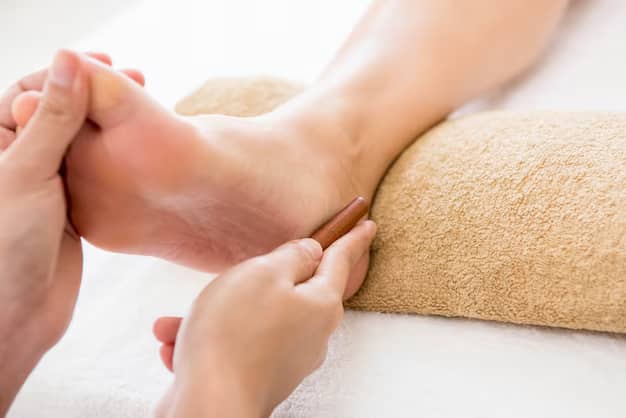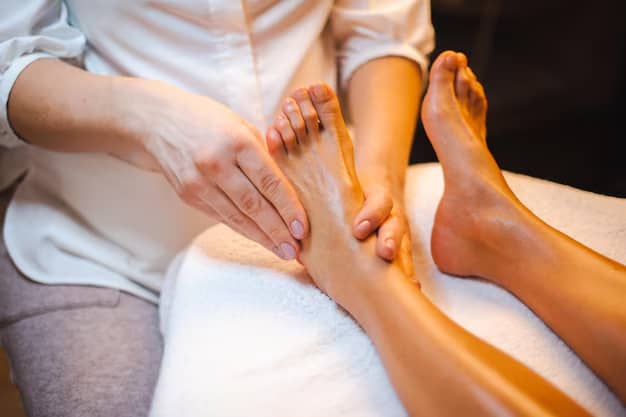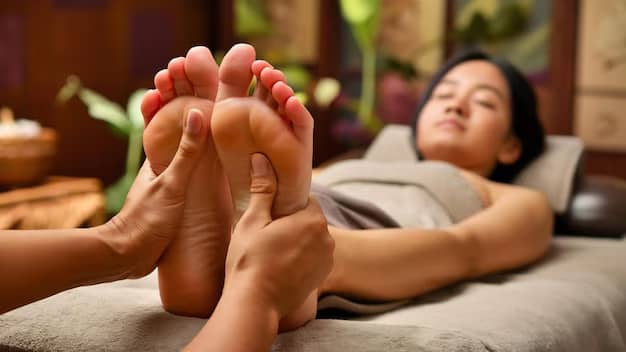
Reflexology can be executed in a home setting, and de-stressing and beneficial health effects can be gained in the privacy and comfort of one’s home. When appropriate techniques are used, reflex points on the feet, hands, and ears are sufficiently stimulated to drive away tension, improve circulation, and promote well-being in general. To fully benefit from reflexology in the comfort of one’s home, a proper setting must be established.
How can I set up a healing space for reflexology at home?
To set up a healing space for reflexology at home, choose a quiet area with soft lighting, calming music, and a comfortable chair or recliner. Ensure the environment is peaceful to enhance relaxation and focus on self-care.
Setting up a healing space in the home begins with a quiet and clutter-free area to bring about relaxation. This ambiance should always have gentle soft lighting and should go hand in hand with soothing sounds of nature or instrumental tracks. Ideally, a cozy chair or recliner is supposed to be sited at a place that can easily access the feet or hands for reflexology.
For example, aromatherapy with lavender and eucalyptus essential oils can add even more ambiance and make it an extremely relaxed atmosphere. All of these things are integrated into your space to create a peaceful ambiance in which to reflexologize either yourself or others.
What tools do I need to practice reflexology at home?
To practice reflexology at home, you need tools such as a reflexology chart, comfortable seating, and optional tools like reflexology sticks or massage oils to enhance pressure and relaxation.
Practicing reflexology at home is pretty straightforward, requiring only a few minimal tools to properly treat. A reflexology chart is crucial since it will guide you through identifying the pressure points of the body. Comfortable seating like a recliner or soft chair allows convenient access to either the feet or hands.
Tools that are optional comprise reflexology sticks or massage balls in order to aid deeper pressure application on specific points, and even in massage oils to promote relaxation and enhance energy flow. These tools come in very handy in making it easier to undertake reflexology practically within the confines of home.

How do I perform reflexology on my feet at home?
To perform reflexology on your feet at home, apply firm pressure to reflex points using your thumb or fingers, focusing on areas that correspond to your body’s organs. Use a reflexology chart for guidance.
Reflexology on your feet in a home setting involves the application of firm, even pressure to specific reflex points using your thumb or fingers. Start with a reflexology chart, which can indicate which parts of your feet will correspond to other parts of your body.
For instance, the arch of the foot is good for relieving digestive disorders; gently press and massage each point for several seconds using circular motions or deep pressure if comfortable. Reflexology sticks or massage tools may help if you need more pressure. Stress can be reduced and well-being enhanced with regular practice.
Can I practice reflexology on my hands at home?
Practicing reflexology on your hands at home is simple. Use your thumb to apply pressure to reflex points, focusing on areas that relate to specific body parts. A reflexology chart will help guide the process.
Home Practice Convenience One of the advantages of hand reflexology is the ability to practice it in your home. Still, if foot reflexology is too painful or just not practical at times, then hand reflexology may be completed for exercise while traveling or at work. Locate the organs of your body with a hand reflexology chart.
The pressure should be done with the fleshy part of your thumb on the area that you are working with – for instance, the entire area of the thumb would work the brain or head area. Massage each point for a few seconds in a circular motion. Hand reflexology can be performed by anyone to help oneself to feel less stressed anywhere and everywhere, thus making it the most practical home therapy.
How often should I practice reflexology at home?
Practicing reflexology at home 2-3 times per week is recommended for general wellness and relaxation. Sessions can last 15-30 minutes depending on your comfort level and needs.
Regular practice also alleviates stress, helps circulation, and maintains general well-being. However, listen to your body; if one experiences pain or excessive fatigue after sessions, then it’s probably best to reduce either the frequency or the duration. Reflexology should be enjoyable and helpful for your health, so adjust your schedule based on how your body feels.

What are the benefits of practicing reflexology at home?
The benefits of practicing reflexology at home benefits a patient in many ways, such as promoting relaxation, reduces stress, improves circulation, and can relieve minor aches and pains. It offers the convenience of self-care without the need for professional treatment.
By the application of pressure to reflex points you influence the nerve endings and enhance the blood flow, which leads to the relief of minor pains and soreness, particularly in the feet and hands.
Practice daily will ensure that you feel good on your body and have the support for physical as well as mental health. Reflexology can be done from home thus making it possible to have continuous self-practice without having to seek a professional. This makes it very accessible and affordable to improve your well-being.
What precautions should I take when practicing reflexology at home?
Precautions to consider while practicing reflexology at home are, to avoid applying too much pressure and stop if you feel pain. Consult a doctor if you have medical conditions, such as circulatory issues or pregnancy, before starting.
Reflexology is pretty safe when done at home. However, you do need to be careful and mindful of certain things. Do not apply too much pressure because that can hurt or cause bruising. It is acceptable to feel pain anywhere in the session, but you will have to stop right then and there.
People suffering from medical conditions such as circulatory disorders or diabetes also require that they first see a doctor, and the same is true with those who are pregnant since their health must be checked out. Precautions like these ensure that reflexology is not damaging to you but rather proves to be beneficial to you due to your specific health condition without causing any damage to you whatsoever.
In Conclusion
Proper tools, environment, and understanding of techniques can turn home-based reflexology into the ultimate self-practice. Reflexology will give relaxation and better circulation, therefore easing everyday stress for many users. If appropriate guidelines and cautions are coupled with these practices, you can create a healing environment conducive to overall wellness and balance. Reflexology at home is one’s way of indulging in health and wellness.

